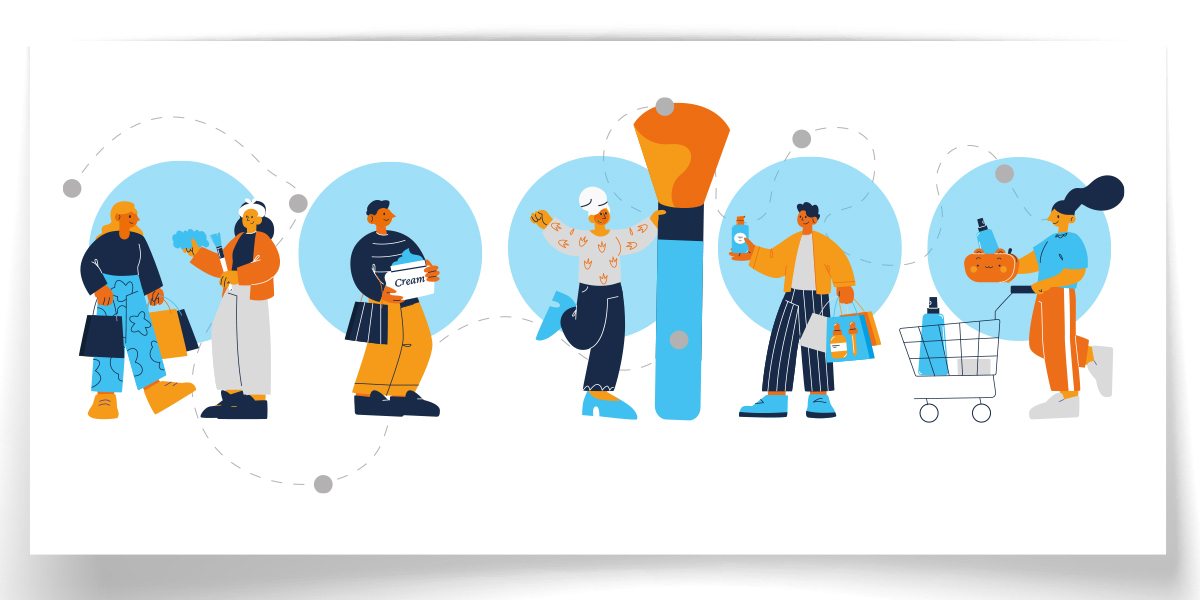The beauty industry is a thriving global market, projected to be worth $580 billion by 2027, according to McKinsey. With 64% of consumers trying new facial skincare products in 2022, and 56% of them considering repurchasing, it’s clear that beauty enthusiasts are constantly on the lookout for innovative products and exceptional customer experiences.
This huge industry isn’t just about products; it’s about making people feel confident and enhancing their everyday lives. As with any industry, delivering an exceptional customer experience is paramount, and the beauty industry is no exception. In this blog post, we’ll explore how the beauty industry can improve consumers’ daily lives by seamlessly integrating technology and personalized services.
Version 1: The frustration of choice
Meet Sarah, a passionate beauty enthusiast who loves to experiment with skin care products. One night, she watches her favorite beauty YouTuber rave about a new skincare line. Excited, Sarah clicks on the link in the video description, which takes her to the brand’s website. Once there, she’s bombarded with a wide range of skincare products, each promising incredible results. Sarah’s goal is to create a personalized skincare routine tailored to her skin type and concerns. She begins to add products to her cart, but soon becomes overwhelmed. She’s not sure which ingredients are right for her skin, and the site lacks guidance. Frustration sets in, and she leaves the site without making a purchase, feeling more confused than when she arrived.
Version 2: Beauty made simple with technology
Now let’s make Sarah’s experience a little more customer-friendly. While watching a video from her favorite beauty YouTuber, she notices a link at the bottom of the video that says “Get Your Personalized Skincare Routine. Curious, she clicks it and is taken to a full-screen product advisor. This advisor is a game changer. It asks Sarah a series of questions about her skin type, concerns and goals. Sarah answers each question, and within minutes, the full-screen advisor generates a personalized skincare routine just for her. It includes product recommendations, step-by-step instructions, and even a shopping list. Excited, Sarah clicks the “Add to Cart” button and her selected products are seamlessly added to her shopping cart. The site also offers a subscription option, so Sarah can receive her skincare products regularly without the hassle of re-ordering. She completes her purchase with ease and eagerly awaits the arrival of her new skincare routine.
Connecting the Dots: Insights for Cosmetics and Beauty Brands
These two scenarios highlight key insights that beauty brands can use to increase customer satisfaction and loyalty:
1. Personalization is key
Just as in Version 2, where Sarah received a personalized skincare routine, beauty brands should prioritize personalization. Use innovative technologies, such as full-screen product advisors or skincare quizzes, to tailor product recommendations to each customer’s unique needs. Personalization not only simplifies the shopping process, but also fosters a deeper connection between customers and brands.
2. Simplify the decision-making process
Version 1 illustrated the frustration that can occur when customers are overwhelmed with choices. Beauty brands should strive to simplify the decision-making process. Provide clear guidance, ingredient information, and step-by-step routines to help customers effortlessly navigate your product offerings.
3. Embrace e-commerce and technology
E-commerce is the fastest growing channel for beauty products, with 21% growth from 2019 to 2022. Leverage technology to create easy-to-use websites and apps that provide a seamless shopping experience. Full-screen product advisors, product finders and virtual try-on tools can enhance the online beauty shopping experience.
4. Support challengers and new brands
As challengers – new, smaller beauty brands – continue to disrupt the market, representing 10% of the market and growing nearly four times faster than incumbents, consider ways to support and collaborate with them. Their innovative approaches and agility can bring fresh ideas and products to your audience.
Looking for more inspiration? Take a look at our case study with L’Oréal!
Or are you more interested in the fashion industry? Then join Taylor on a shopping trip as she searches for her perfect outfit and discover how seamless integration of online and offline shopping can revolutionize the fashion journey.
